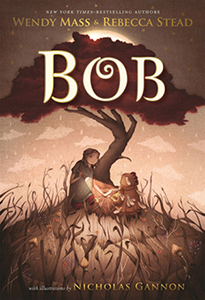2018 School Spending Survey Report
Spring 2018 Publishers' Preview: Five Questions for Wendy Mass & Rebecca Stead
This interview originally appeared in the March/April 2018 Horn Book Magazine as part of the Publishers’ Previews, an advertising supplement that allows participating publishers a chance to each highlight a book from its current list.

This interview originally appeared in the March/April 2018 Horn Book Magazine as part of the Publishers’ Previews, an advertising supplement that allows participating publishers a chance to each highlight a book from its current list. They choose the books; we ask the questions.
Sponsored by![]()
In Mass and Stead’s middle-grade collaboration Bob, Livy (a human girl) and Bob (a…well, they’re not sure what, but decidedly not human) alternately narrate their quest to reunite the little green creature with his family.
 1. Which of you wrote as Livy and
who as Bob?
1. Which of you wrote as Livy and
who as Bob?RS: I wrote the first chapter from Livy’s point of view. In the last scene, Livy flings open a closet door at her grandmother’s house and finds a small green “zombie” standing on a dictionary. I didn’t know who he was or why he was there. Then I handed things over to Wendy. She wrote the second chapter from his point of view, and we just tag-teamed it from there.
2. Why “Bob”? (It’s an unremarkable name for such a remarkable character.)
WM: That’s pretty much it: the juxtaposition of the name and his character just cracked me up. Also, my son knew he would be allowed to choose his own middle name when he turned ten, and after debating for nearly a decade, on his tenth birthday he announced that his middle name was now Bob. Bob! That kid! And now, our little green non-zombie.
 3. What sources did you draw upon for this tale?
3. What sources did you draw upon for this tale?RS: I thought a lot about fairy tales and re-read my old Juniper Tree collection as the story progressed. But what I drew upon most was Sylvester and the Magic Pebble. The idea that you could so easily lose yourself, and your loved ones, was scary and powerful to me as a kid.
4. Do you ever wonder if some imaginary friends aren’t so imaginary?
WM: I never had an imaginary friend, although I was sure my stuffed animals led very full lives while I was at school! We knew early on that Bob wouldn’t actually be imaginary, and spent a lot of time figuring out the rules of who could and couldn’t see him. It adds an important layer to the mystery of who Bob is.
5. Bob’s magical “species” turns out to be quite important ecologically. What’s something we nonmagical creatures can do to help our planet?
RS: One small thing this nonmagical creature is doing: I never take a plastic bag from a store if I can help it. I have walked down Broadway with a bunch of bananas in one hand, a loaf of bread in the other, and pockets stuffed with cat food.
Sponsored by![]()
RELATED
RECOMMENDED
ALREADY A SUBSCRIBER? LOG IN
We are currently offering this content for free. Sign up now to activate your personal profile, where you can save articles for future viewing.







Add Comment :-
Be the first reader to comment.
Comment Policy:
Comment should not be empty !!!